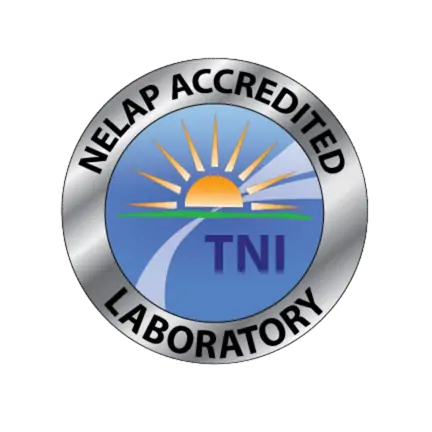EPA Method 8260: Analysis of Volatile Organic Compounds
At Teklab, we understand the critical importance of accurately identifying and quantifying environmental contaminants. Among the most prevalent and often challenging groups of pollutants are Volatile Organic Compounds (VOCs). These chemicals are defined by their high vapor pressure at room temperature, meaning they readily evaporate into the atmosphere, impacting air quality, soil, and groundwater.
EPA Method 8260 is the definitive analytical technique used to detect and measure these compounds in a wide array of environmental matrices. It’s a cornerstone method for site assessments, regulatory compliance, and understanding environmental risks posed by VOCs.
If you would like more information about the specific methodology used to test samples utilizing this application, view the EPA.gov website for method 8260 (SW-846).
Volatile Organic Compounds (VOCs)
VOCs are a diverse class of organic chemicals that typically have low boiling points and high solubility in water, allowing them to move easily through different environmental media. Common sources include:
- Petroleum Products: Gasoline, diesel, heating oil, lubricants.
- Industrial Solvents: Used in manufacturing, degreasing, dry cleaning.
- Consumer Products: Paints, glues, aerosols, cleaning supplies.
- Byproducts of Chemical Processes: Formed during various industrial reactions.
- Exposure to VOCs can pose significant health risks, ranging from short-term effects like headaches and nausea to long-term health concerns like cancer and damage to organs.
The Teklab Advantage: Expertise in Purge-and-Trap GC/MS
At Teklab, our proficiency in EPA Method 8260 is built upon state-of-the-art Purge-and-Trap Gas Chromatography/Mass Spectrometry (GC/MS) technology, combined with the unparalleled expertise of our analytical chemists. This advanced technique is specifically designed to handle the unique properties of VOCs. An inert gas (typically helium) is bubbled directly through the environmental sample (water, soil, air). Due to their volatility, the VOCs rapidly partition from the sample matrix into the gas stream. The gas stream, now carrying the VOCs, is then passed through an adsorbent trap. This trap efficiently captures and concentrates the VOCs while allowing the inert carrier gas to pass through. This crucial step concentrates the analytes from potentially very dilute samples, allowing for ultra-low detection limits. The trap is then rapidly heated to a high temperature. This process quickly releases (desorbs) the concentrated VOCs from the trap in a narrow “slug” of vapor, directly into the Gas Chromatograph.
The desorbed VOCs enter the GC column, which is housed within a temperature-controlled oven. As the individual VOCs travel through the column, they separate from each other based on their unique chemical and physical properties (e.g., boiling points, polarity). This separation creates distinct peaks, each corresponding to a specific VOC, which elute from the column at characteristic “retention times.”
As each separated VOC exits the GC column, it enters the Mass Spectrometer. Within the MS, the VOC molecules are ionized (e.g., by electron impact ionization) and fragmented into smaller, charged particles.
The MS then measures the mass-to-charge ratio (\(m/z\)) of these fragments, generating a unique pattern known as a “mass spectrum” or “fragmentation pattern.” This mass spectrum serves as a highly specific chemical fingerprint, allowing our analysts to definitively identify each VOC by comparing its spectrum to a vast library of known compounds. The intensity of the MS signal is directly proportional to the amount of the compound present, enabling precise and accurate quantification of each VOC in your sample.
What Types of VOCs Does EPA Method 8260 Target?
EPA Method 8260 is capable of analyzing a very extensive list of VOCs, typically encompassing 60 to 80 (or more) common compounds. The specific analytes included in your report will depend on the regulatory requirements for your project and the known or suspected contaminants at your site. Common categories and examples include:
- BTEX Compounds (Aromatic Hydrocarbons): Benzene, Toluene, Ethylbenzene, and Xylenes. These are primary components of gasoline and widely used in industrial processes.
- Chlorinated Solvents: Trichloroethene (TCE), Tetrachloroethene (PCE), Vinyl Chloride, 1,1,1-Trichloroethane (TCA), Methylene Chloride. These are common industrial degreasing agents and dry-cleaning chemicals.
- Fuel Oxygenates: Methyl tertiary-butyl ether (MTBE), Ethanol, tert-Butyl alcohol (TBA). Additives used in gasoline to improve combustion.
- Halogenated Alkanes/Alkenes: Chloroform, Carbon Tetrachloride, 1,2-Dichloroethane, 1,2-Dichloropropane.
- Other Aliphatic & Aromatic Analytes: Acetone, 2-Butanone (MEK), Styrene. Aliphatic and aromatic analytes are two broad categories of organic compounds that differ significantly in their structure and properties, particularly in the context of analytical chemistry. Aliphatic compounds are non-aromatic, meaning they don’t contain ring structures with alternating single and double bonds, while aromatic compounds are cyclic and possess a unique type of bonding that leads to stability and different reactivity patterns. In analysis, these differences are often exploited to separate or identify these compounds using techniques like chromatography and mass spectrometry.
This comprehensive range makes Method 8260 invaluable for understanding complex contamination scenarios. EPA Method 8260 is a foundational method mandated or widely referenced by various federal and state environmental regulations due to its ability to provide high-quality, defensible data for VOC analysis. Our services are crucial for:
RCRA (Resource Conservation and Recovery Act)
- Hazardous Waste Characterization: Identifying and quantifying VOCs that classify a waste as hazardous (e.g., through the Toxicity Characteristic Leaching Procedure – TCLP).
- Groundwater Monitoring: At hazardous waste treatment, storage, and disposal facilities (TSDFs), Method 8260 is routinely used to monitor groundwater for potential VOC contamination.
- Corrective Action: Assessing the extent of VOC contamination, tracking plume migration, and verifying cleanup effectiveness during remedial activities.
CERCLA (Comprehensive Environmental Response, Compensation, and Liability Act – Superfund)
- Site Investigations: Method 8260 is a primary tool for characterizing soil, groundwater, and air at Superfund sites, where VOCs from industrial spills or improper disposal are common.
- Risk Assessment: Providing the necessary data to evaluate potential human health and ecological risks posed by VOCs.
- Remedial Actions: Monitoring the progress and success of remediation technologies designed to treat or remove VOCs.
- State Environmental Programs: Most state departments of environmental protection, pollution control, or hazardous waste management agencies specify EPA Method 8260 (or an approved equivalent) for groundwater assessments, soil cleanups, underground storage tank (UST) investigations, and brownfield redevelopment projects.
NPDES (National Pollutant Discharge Elimination System) Permits
While Method 624 (for wastewater) is also common, Method 8260 may be specified in NPDES permits for certain industrial wastewater discharges where VOCs are known or suspected pollutants. Our commitment to delivering accurate and reliable results is reflected in our meticulous adherence to Method 8260 protocols. We provide specific sample containers (e.g., VOA vials with septa for water, specially designed jars for soil) to minimize VOC loss. Proper preservation, including refrigeration and often chemical preservation (e.g., HCl for water to inhibit biodegradation), is rigorously followed. Our team ensures adherence to strict holding times (e.g., 14 days from collection to analysis for most VOCs) to guarantee sample integrity.
Teklab invests in the latest Purge-and-Trap GC/MS systems, optimized for maximum sensitivity and throughput. Our experienced chemists possess in-depth knowledge of VOC chemistry, GC/MS operation, and data interpretation. They expertly handle complex matrices and ensure high-quality data generation. Every analytical batch includes a comprehensive suite of QC samples: method blanks (to check for contamination), laboratory control samples (to verify accuracy), matrix spikes (to assess matrix effects), and surrogates (to monitor overall method performance). This stringent QC ensures the defensibility of your data. Teklab provides clear, concise, and detailed reports, including all detected VOCs, their concentrations, method detection limits (MDLs), reporting limits (RLs), and relevant quality control data.
Why Choose Teklab for Your EPA Method 8260 Needs?
Choosing the right analytical partner for VOC analysis is crucial. At Teklab, we distinguish ourselves through:
- Accreditation: We are [mention your specific accreditations, e.g., NELAP-accredited] for EPA Method 8260, demonstrating our unwavering commitment to the highest standards of quality and technical competence.
- Experience: Decades of experience in environmental analytical testing, handling a vast array of challenging samples and project types.
- Fast Turnaround Times: We understand the urgency of environmental projects and strive to provide efficient turnaround times without compromising data quality.
- Customer-Centric Approach: Our dedicated project managers and technical staff are available to answer your questions, provide guidance on sampling protocols, and ensure your project’s success.
- Comprehensive Analytical Solutions: Beyond 8260, we offer a full suite of environmental testing services, making us a one-stop solution for your analytical needs.
Don’t leave your VOC analysis to chance. Partner with Teklab’s experts to ensure accurate, reliable, and regulatory-compliant data.
Contact Teklab today to discuss your specific project requirements or to request a quote for EPA Method 8260 analysis.




